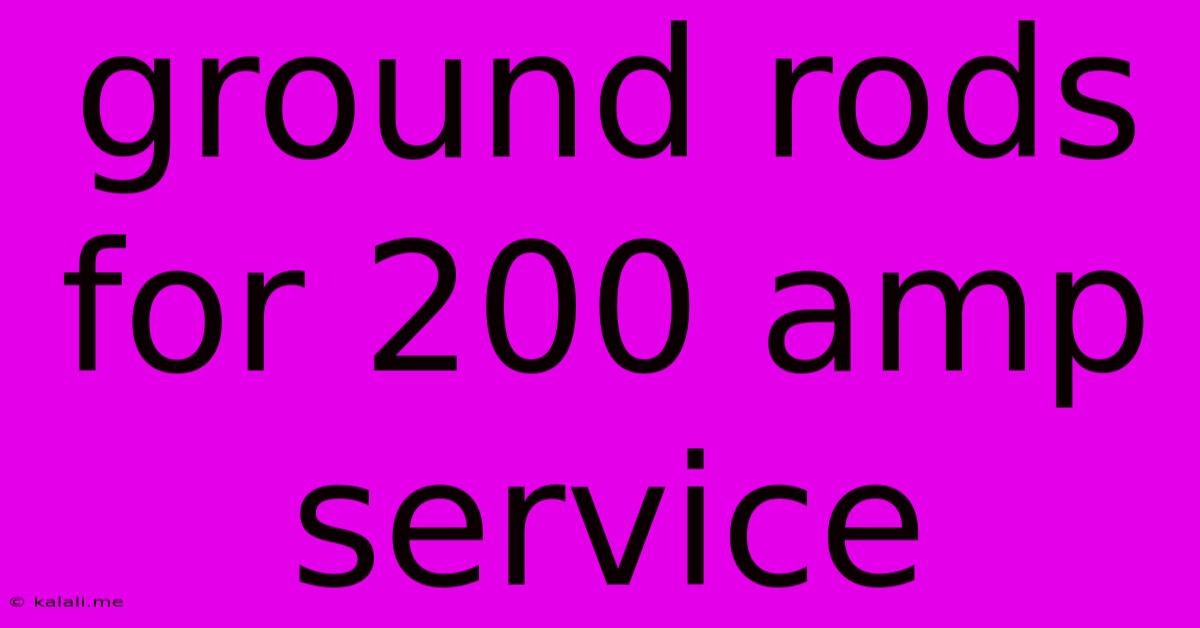Ground Rods For 200 Amp Service
Kalali
Jun 01, 2025 · 3 min read

Table of Contents
Ground Rods for 200 Amp Service: Ensuring Electrical Safety
Meta Description: This comprehensive guide explains the importance of ground rods for a 200-amp service, covering code requirements, installation best practices, and troubleshooting common issues. Learn how to ensure optimal electrical safety and grounding for your home or business.
Getting a 200-amp electrical service is a significant upgrade for any home or business, offering increased capacity for power-hungry appliances and devices. However, simply increasing the amperage isn't enough; ensuring proper grounding is crucial for safety and preventing electrical hazards. This article will delve into the specifics of ground rods for a 200-amp service, covering everything from code requirements to best practices for installation.
Understanding the Importance of Grounding
Grounding your electrical system is paramount for safety. A properly installed grounding system provides a low-impedance path for fault currents to flow to the earth, preventing dangerous voltage buildup and protecting people and equipment from electric shock. In the event of a short circuit or ground fault, the excess current is safely diverted to the ground, preventing fires and electrocution. This is especially critical with a higher-amperage system like a 200-amp service, which carries a greater potential for fault currents.
Code Requirements for Grounding a 200-Amp Service
Electrical codes, like the National Electrical Code (NEC) in the US, specify stringent requirements for grounding systems. These regulations ensure a consistent level of safety across all installations. Key aspects regarding ground rods for a 200-amp service typically include:
- Number of Ground Rods: The NEC often mandates multiple ground rods for increased redundancy and lower overall ground impedance. The exact number may vary depending on soil conditions and local regulations, but multiple rods are generally recommended for a 200-amp service.
- Rod Material and Length: Copper-clad steel rods are commonly used due to their corrosion resistance and conductivity. The required length of the rods depends on soil resistivity. They typically need to be driven deep enough to reach consistently moist soil.
- Spacing and Arrangement: Ground rods should be spaced a certain distance apart (typically 6 feet) to avoid interference and ensure a lower overall ground impedance. Proper spacing helps maximize the effectiveness of the grounding system.
- Ground Rod Connection: All ground rods must be connected together using a properly sized and insulated grounding conductor. This ensures that all rods work together as a single grounding electrode system. This system then connects to the electrical panel's grounding bus bar.
Installing Ground Rods for Optimal Performance
Proper installation of ground rods is key to a safe and effective grounding system. Consider these best practices:
- Soil Testing: Before installation, it's wise to conduct soil resistivity testing to determine the best rod length and placement for optimal grounding. This test helps you understand the ground’s ability to dissipate electrical current.
- Rod Driving: Ground rods should be driven vertically into the earth using a specialized driving tool. Ensure they are driven straight to achieve maximum contact with the surrounding soil.
- Connections: Use the correct size and type of grounding conductor and clamps to create secure and corrosion-resistant connections between the rods and the main grounding electrode.
- Inspection: After installation, a qualified electrician should perform a ground resistance test to verify that the grounding system meets code requirements and offers adequate protection.
Troubleshooting Grounding Issues
If you suspect a problem with your grounding system, it’s essential to seek professional help. However, some common signs of grounding issues include:
- Tripped Circuit Breakers: Frequent tripping of circuit breakers might indicate a grounding fault.
- Electrical Shocks: Experiencing shocks when touching appliances or electrical fixtures is a serious sign of a grounding problem.
- Flickering Lights: Inconsistent lighting can sometimes point to grounding problems.
Ignoring grounding issues can lead to serious consequences. Regular inspection and maintenance are essential for ensuring your 200-amp service remains safe and reliable.
Remember, working with electricity can be dangerous. Always consult with a qualified electrician for any electrical work, particularly concerning grounding systems. This article provides general information and should not be considered a substitute for professional advice.
Latest Posts
Latest Posts
-
How To Remove Adhesive From Wood
Jun 03, 2025
-
Word Thats Means To Step Into The Performce Ofa Character
Jun 03, 2025
-
What Size Hole For 3 8 Bolt
Jun 03, 2025
-
What Size Wire 40 Amp Breaker
Jun 03, 2025
-
Minecraft Give Item With Low Durability
Jun 03, 2025
Related Post
Thank you for visiting our website which covers about Ground Rods For 200 Amp Service . We hope the information provided has been useful to you. Feel free to contact us if you have any questions or need further assistance. See you next time and don't miss to bookmark.